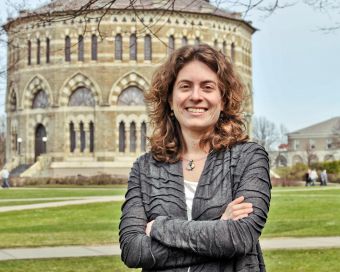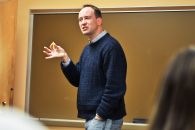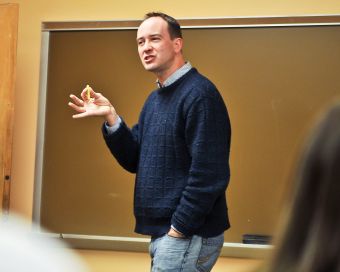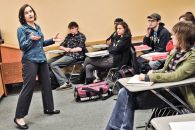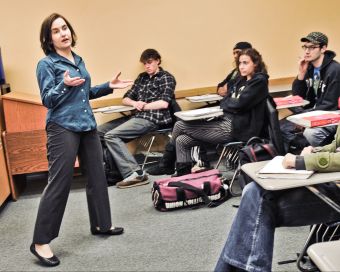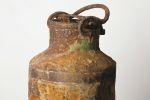Schenectady, N.Y.
Union College, long focused on engineering and the liberal arts, five years ago adopted a new educational mission: teaching its students to be ethical. It established an Ethics Across the Curriculum program that encourages faculty members to weave discussions of ethics into all of their courses, no matter the subject.
Although faculty throughout the college's four academic divisions have gotten behind the effort, it is hard to tell what, if any, effect it is having.
Here and elsewhere in academe, ethics instruction remains a means to unclear ends.
At a time when policy makers and parents are questioning the usefulness of a liberal education, many colleges have touted their ability to produce graduates with a moral compass. "Ethical reasoning and action" is one of the "essential learning outcomes" that the Association of American Colleges and Universities says is "best developed by a contemporary liberal education." But these days, making that claim is not enough: The accountability movement has put colleges under pressure to assess students' progress in meeting all educational goals. Assessing ethical learning is especially challenging.
Sure, colleges can test students' recall of class lectures or assigned readings. But being able to parrot Plato is a far cry from skillfully applying moral philosophy to today's moral dilemmas.
Colleges might even be able to measure whether their students have become more sophisticated in the thought processes they use in working through ethical problems. But the most widely used instruments for measuring moral reasoning are intended for research or to evaluate institutions, not for student grading, and educators disagree on their validity.
When it comes to measuring whether ethics instruction sticks, making students more likely to do the right thing throughout their lives, about all colleges can do is hope.
No Right Answers?
Many of the higher-education institutions that have chosen to emphasize such instruction have done so in response to some societal crisis widely attributed to ethical lapses—with the economic collapse of 2008 being the latest event to inspire efforts to promote students' moral betterment. But the truth is that there is no telling whether today's college student will go on to become a mensch or the next Bernie Madoff.
Ethical development lies "at the outermost ring" of the learning outcomes institutions are able to measure, says Trudy W. Banta, a professor of higher education at Indiana University-Purdue University at Indianapolis who has extensively studied assessment practices. Of the tests of ethical learning devised so far, she says, "I don't know of anything that is even beginning to be universally accepted."
Anastasia G. Pease, a visiting assistant professor of English at Union College who helped oversee the development of its ethics-teaching effort, says, "We like to think that we are making a difference." But, she adds, "As far as measurement? It's hard."
Among the many challenges in assessing students' development is the lack of universally accepted "right" answers to many moral and ethical problems.
"By definition, you are coming up with some sort of normative value judgment on what the right outcomes are for students," says Richard Arum, professor of sociology and education at New York University and co-author of Academically Adrift: Limited Learning on College Campuses. "It is hard to get objective measures that are not tied in with cultural assumptions."
If colleges send students the message that there exists a correct answer to any given ethical question, Mr. Arum says, they are likely to run into a problem routinely encountered by social scientists whose research involves surveys: People often answer a question with the response they perceive as most acceptable to others, failing to say what they truly believe.
Deni Elliott, a professor of media ethics at the University of South Florida and the founder of ethics centers at both Dartmouth College and the University of Montana, argues that colleges need to separate "instructional objective from pedagogical hope." Although they cannot determine whether they are producing graduates who will make the world better, she says, they can try to determine how well their students grapple with ethical problems.
Union College has left it up to faculty members to individually devise ways to determine how well students absorb and apply ethics lessons. Many of its faculty members gauge learning mainly by judging how well students identify and analyze ethical problems in writing assignments, on essay tests, and in classroom discussions. That approach, widely used throughout academe, puts a premium on ethical reasoning and rewards students for demonstrating critical thinking.
In focusing on cognitive development, however, such assessments get at only one of two key aspects of ethical thinking, argue experts like David T. Ozar, a professor of philosophy at Loyola University Chicago and veteran instructor of journalistic and medical ethics. Also important, he says, is affective learning, the acquisition of attitudes and values that leave one more predisposed to act ethically.
"It is really hard to measure ethical learning because it's not declarative or semantic knowledge, but, like any expertise, it is knowing the right thing to do in the right way at the right time," says Darcia F. Narváez, an associate professor of psychology at the University of Notre Dame. In her research, she has found that intuition plays such a big role in moral decisions that she argues it is a mistake to ignore its influence.
So far, however, about the only efforts to formally assess the noncognitive dimensions of moral development have been in the health professions. The most established instrument for such purposes is the Dental Ethical Sensitivity Test, developed in the early 1980s at the University of Minnesota-Twin Cities. It asks dental students to react to real-life situations, such as a patient resisting treatment or being incapable of giving informed consent, relayed to them via videotape or audiotape. Their responses are assessed by someone working from a detailed scoring manual.
Robert B. Baker, a professor of philosophy and director of Union College's Ethics Across the Curriculum program, helped develop a similar instrument for Union Graduate College, an independent institution spun off from Union College in 2003. Used in a training program for doctors and lawyers on hospitals' ethics committees, and based on a list of core competencies in bioethics developed by the American Society for Bioethics and Humanities, it simulates interactions with hospital patients and their families and rates people on the knowledge and skills they display in tackling whatever issues arise. For every student, the exercise requires 40 hours of intensive testing involving eight faculty members. "This is beyond the resources of anything but a specialized training program," Mr. Baker says. "It is not something an undergraduate college is set up to do."
Response and Reason
When it comes to assessing the moral development of undergraduate students, the most widely used instruments are the Defining Issues Test, or DIT, developed in the early 1970s, and a second-generation version of it, known as the DIT2, developed in 1999.
Stephen J. Thoma, a professor of educational psychology at the University of Alabama at Tuscaloosa, oversees worldwide use of the two tests as executive director of the Tuscaloosa-based Center for the Study of Ethical Development. He estimates that each year about 50 researchers around the world give one of the two tests to a total of about 40,000 people, mostly at colleges and graduate schools. About three-fifths of the tests are administered for the sake of evaluating institutions' or programs' success in ethics education.
James Rest, an educational psychologist at the University of Minnesota-Twin Cities, devised the Defining Issues Test based on the work of Lawrence Kohlberg, a psychologist at Harvard University and the University of Chicago. Mr. Kohlberg theorized that moral reasoning develops along a six-stage continuum, progressing from judgments based purely on self-interest and the desire to avoid punishment, through judgments based on a desire to obey the law and comply with societal norms, to judgments based on moral principles and ideals.
Whereas Mr. Kohlberg developed a labor-intensive interview to assess the sophistication of his subjects' moral reasoning, the two versions of the Defining Issues Test are administered in a written, multiple-choice format. Test takers read stories posing moral questions, then select from a list of options which course of action the protagonist should take. They then rate how much weight they gave various considerations in reaching their conclusions and rank which considerations most influenced their decisions.
Among the factors researchers have taken into account in attempting to validate the test are differences among respondents of varying ages and educational levels and correlations between test results and the results of various measures of cognitive capacity. Those who give the tests, either in writing or online, are supposed to submit subjects' answers to the Center for the Study of Ethical Development, to be scored for a fee.
Whose Values?
Early on, the Defining Issues Test was suspected of being biased against women, based heavily on assertions by Carol Gilligan, a psychologist now at New York University, that Mr. Kohlberg's theory of moral development placed more value on an individualistic, rights-based approach to morality she attributed to men than on the relationship- and caring-based approach she attributed to women. Numerous studies of the test, however, have found that, if anything, women do slightly better on it than men.
Charles F. Blaich, director of the Wabash National Study of Liberal Arts Education, calls the Defining Issues Test "a good, solid measure" that "has been around a long time." His research effort uses the DIT2 to gauge how well the colleges involved develop students' moral reasoning.
Despite such endorsements, others in higher education have resisted using either version of the test.
Among the concerns raised is that the test has an inherent liberal bias. Based on Mr. Kohlberg's theories and calibrated partly to the moral reasoning used by graduate students in philosophy and political science, the test rewards subjects who, for example, say that a man would be justified in stealing an otherwise-inaccessible drug for his dying wife or that a doctor should grant a terminally ill patient's wish to be provided a fatal dose of a painkiller. The debate over the bias accusation has a chicken-and-egg dimension, with proponents of the test saying advanced moral reasoning generally leads to liberal views, and critics saying the test incorporates liberal views into its criteria for advanced moral reasoning.
With its multiple-choice format, the test also might overstate moral-reasoning ability by assessing people's capacity to recognize advanced reasoning, not their ability to actually engage in it.
The influence of cognitive ability and prior learning on test scores also raises concerns. If students at a highly selective college do well the first time they take the test, asks Ms. Banta, of Indiana University-Purdue University at Indianapolis, does it hold much value as a measure of students' moral growth?
Mr. Baker has similarly decided not to use the test at Union College, based on his observation that students in some fields, such as engineering and business, tend to do worse than others on it, and that students' scores can fluctuate markedly as they move through their majors. "I am not sure what, in the end, it measures," he says.
The organization that oversees the test, the Center for the Study of Ethical Development, discourages the use of the defining-issues tests in assigning grades, although it does regard giving students feedback based on test results as acceptable.
Among the others who have sought to develop ways to measure ethical learning, the Association of American Colleges and Universities has created a rubric for evaluating ethical learning displayed in students' work. It includes benchmarks for measuring students' ethical self-awareness, capacity to recognize ethical issues, and ability to understand, apply, and justify the use of different ethical perspectives and concepts. Terrel L. Rhodes, vice president of the association's office of quality, curriculum, and assessment, estimates that several hundred colleges have used its ethics rubric since the document was released in 2009.
Preaching and Practice
Union College began a pilot version of its ethics-instruction program, in economics, in 2003, and expanded the effort to other academic programs three years later. The undertaking has been financed by Michael S. Rapaport, a 1959 graduate who conceived it in response to the ethical blindness shown by executives caught up in the Enron financial-reporting scandal of 2001. He says it bothered him that people with advanced degrees, some from the nation's most prestigious universities, "did not have a clue that they had done anything wrong."
The Union program seeks to promote ethical development through both the application of moral philosophy to various academic fields and practical discussions of the ethical codes under which those fields operate.
The instruction plays out in different ways across campus. In one classroom, Brian R. Hauser, an assistant professor of English, asked students in his introductory literature course to discuss fictional characters who forge pacts with devils. Elsewhere, Jeffrey D. Corbin, assistant professor of biology, walked students in his introductory environmental-studies course through a simulation in which they played the roles of oil-company representatives, city-council members, or environmental activists and discussed environmental-justice concerns raised by the construction of a refinery in a low-income area.
Faculty members involved in the effort met this winter to compare notes on approaches that seemed to be improving their students' ability to spot and deal with ethical problems posed to them in assignments and on tests. At about the same time, however, a committee of students, administrators, and faculty members gathered elsewhere on campus to talk over an effort to stem cheating through the adoption of a new honor code. Kristen A. Bidoshi, Union's dean of studies, estimates that she deals with roughly 200 cases of academic dishonesty each year, out of a total undergraduate enrollment of about 2,500.
Claire M. Bracken, assistant professor of English at Union College and a member of the steering committee for its ethics-education effort, says she is hopeful that getting students "passionate and engaged with these issues" will lead them to retain the ethics lessons learned in college classrooms and behave more ethically throughout life.
But, she acknowledges, "There is no good way of knowing what they are thinking when they leave."






